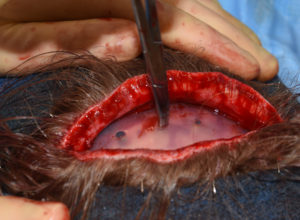Custom 3D implants are, by far, the most effective method for any form of aesthetic skull augmentation. By creating a preformed implant that has a presurgically chosen shape and thicknesses based on the patient’s actual bony skull anatomy and aesthetic desires, this removes the inaccuracies that naturally come from intraoperatively fashioned augmentations that are made from various forms of bone cements.
The other huge advantage of custom 3D skull implants is that the preformed shape allows placement through much smaller scalp incisions. This aesthetic advantage is made possible because the implant material allows for temporary deformation to pass through an incisional length than is more narrow than the implant’s diameter.
One interesting aspect of having a small scalp incision through which a custom skull implant is placed is that only a fraction of the implant can be visualized through it. Once placed on the bone the implant always needs to be moved around and positioned but doing so can be difficult because the tight fit of the implant makes it challenging to move.

Self-made perfusion holes in custom 3D skull implants serve a dual role of which implant positioning is their immediate intraoperative benefit. Their point of purchase allows the implant to be slid around on the convex skull bone surface
Dr. Barry Eppley
Indianapolis, Indiana


